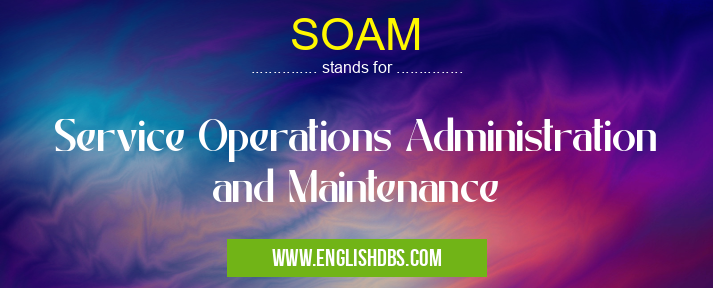What does SOAM mean in UNCLASSIFIED
SOAM stands for Service Operations Administration and Maintenance. It is a framework and set of best practices that help organizations manage and maintain their IT services effectively and efficiently. SOAM focuses on the entire lifecycle of IT services, from planning and design through to operation and maintenance.

SOAM meaning in Unclassified in Miscellaneous
SOAM mostly used in an acronym Unclassified in Category Miscellaneous that means Service Operations Administration and Maintenance
Shorthand: SOAM,
Full Form: Service Operations Administration and Maintenance
For more information of "Service Operations Administration and Maintenance", see the section below.
Introduction to SOAM
Key Components of SOAM
- Planning and Design: Defines the scope, requirements, and architecture of IT services.
- Operation: Includes activities such as monitoring, troubleshooting, and incident management.
- Maintenance: Involves regular updates, patches, and enhancements to ensure service availability and performance.
- Administration: Covers tasks such as user management, access control, and configuration.
- Governance: Ensures compliance with policies and regulations, and provides oversight of service operations.
Benefits of SOAM
SOAM offers numerous benefits, including:
- Improved service availability and performance: By proactively monitoring and maintaining services, SOAM helps minimize downtime and ensure optimal performance.
- Reduced costs: SOAM streamlines operations, reduces the need for reactive maintenance, and improves resource allocation.
- Enhanced security: SOAM includes security measures to protect IT services from threats and unauthorized access.
- Improved customer satisfaction: SOAM ensures that IT services meet the needs of users and stakeholders, resulting in increased satisfaction.
SOAM Implementation
Implementing SOAM involves:
- Defining roles and responsibilities: Clearly outlining the roles of personnel involved in service operations.
- Establishing processes and procedures: Developing standardized processes for planning, operation, maintenance, and administration.
- Implementing tools and technologies: Utilizing tools to automate tasks, monitor services, and manage incidents.
- Training and development: Providing ongoing training to personnel to ensure they have the necessary skills and knowledge.
- Continuous improvement: Regularly reviewing and improving SOAM practices to optimize service operations.
Essential Questions and Answers on Service Operations Administration and Maintenance in "MISCELLANEOUS»UNFILED"
What is Service Operations Administration and Maintenance (SOAM)?
SOAM is a comprehensive framework for managing the operational aspects of IT services. It includes processes for planning, provisioning, monitoring, and maintaining IT services to ensure they meet agreed-upon service levels.
What are the key components of SOAM?
The key components of SOAM include:
- Service Level Management (SLM): Defines and monitors service level agreements (SLAs) to ensure services meet customer expectations.
- Capacity Management: Ensures sufficient resources are available to meet service demand.
- Availability Management: Maximizes service uptime and minimizes disruptions.
- Performance Management: Monitors and evaluates service performance to identify and address bottlenecks.
- Security Management: Protects services from unauthorized access, use, disclosure, disruption, modification, or destruction.
What are the benefits of implementing SOAM?
Implementing SOAM can provide numerous benefits, including:
- Improved service availability and performance
- Reduced operational costs
- Enhanced customer satisfaction
- Increased efficiency and productivity
- Improved compliance with regulatory requirements
How does SOAM complement other ITIL Service Management processes?
SOAM is closely aligned with other ITIL Service Management processes, such as:
- Service Design: Ensures services are designed to meet customer needs and technical specifications.
- Service Transition: Manages the transition of services from development to production.
- Continual Service Improvement (CSI): Continuously monitors and evaluates services to identify and implement improvements.
Final Words: SOAM is a crucial framework that helps organizations maximize the effectiveness and efficiency of their IT services. By following SOAM practices, organizations can improve service availability, reduce costs, enhance security, and increase customer satisfaction.
